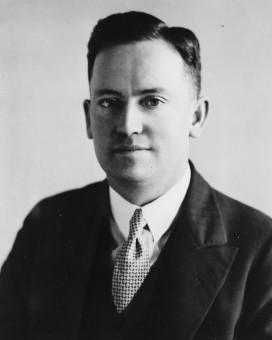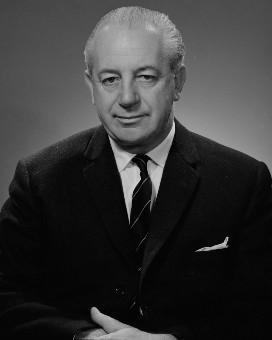Elizabeth McKenzie and Joseph Benedict (Ben) Chifley married on 6 June 1914, when they were in their late 20s. Both had been born in Bathurst, New South Wales, and they lived there all their lives. Their own home at 10 Busby Street was a small stone cottage given to Mrs Chifley by her parents. Their car was a T-model Ford, also a gift from her parents. By the time he became Prime Minister in 1945, Chifley had replaced the Ford with a Buick, but they remained in the same modest house.
Like Chifley, Mrs Chifley was active in Bathurst’s local civic organisations and in church activities. Unlike him, she left no evidence of any interest in the labour movement or in politics. Neither are there records of her views on the major issues of her lifetime – the 2 world wars, the conscription plebiscites in 1916 and 1917, the crises in 1916 when Prime Minister William Hughes left the Labor Party and in 1931 when Joseph Lyons did the same, nor the passionate and divisive issue of Communism in the 1940s and 1950s.
Although Mrs Chifley was described as confident, gracious, and with a charming and friendly manner, these attributes were not employed in any of Chifley’s federal election campaigns. The most obvious reason for this was her physical frailty, a spinal disease that increasingly impaired her mobility. Voters recalled her sitting in the couple’s car outside polling booths, chatting to passing friends and acquaintances, presumably with Chifley busy somewhere in the vicinity.
When Chifley first won a parliamentary seat in 1928, the couple had been married for 14 years. Mrs Chifley did not travel to Canberra at all between 1932, when Chifley lost his seat, and 1946, 9 months after he became Prime Minister. In January 1945, she went to Sydney for the official function to welcome the new Governor-General. The Chifleys were needed at the arrival of the Duke and Duchess of Gloucester, as Prime Minister John Curtin was then recovering from the heart attack that had hospitalised him in Melbourne and Chifley was deputising for him. This was clearly an arduous undertaking for Mrs Chifley. The drive from Bathurst took 2 days to allow her sufficient rest.

Elizabeth and Ben Chifley welcome the Governor-General, the Duke of Gloucester, on his visit to Bathurst in 1945 when the new Governor-General flew his aeroplane on a familiarisation tour of several states. By kind permission Fred Smith.
Mrs Chifley’s mother, who had lived with the Chifleys since 1931, died 6 weeks after John Curtin in 1945. When Chifley became Prime Minister that July, Mrs Chifley remained at their Bathurst home with her ailing mother. Her first trip to Canberra as prime ministerial spouse was in March 1946, when she was at The Lodge for a month and attended functions associated with the opening of the parliamentary session. When Chifley departed for the conference of Commonwealth prime ministers in London in May, she returned home to Bathurst.
In 1929, when The Lodge was only 2 years old, Labor Prime Minister James Scullin and Sarah Scullin had refused to live there, arguing the official residence was an unnecessary extravagance in the depression years. This meant close attention was focused on use of The Lodge by both subsequent Labor prime ministers, John Curtin and Ben Chifley. More precisely, close attention was focused on the living arrangements made by the prime ministerial wives. After the Bruces, the large Lyons family, and then the Menzies lived there, residence at The Lodge seems to have become a benchmark of performance of the duties of prime ministerial spouse. Like Elsie Curtin, Mrs Chifley was subject to close scrutiny on this point by journalists at the time, and by historians since.
That Mrs Curtin and Mrs Chifley maintained their family homes while their husbands were away much of the time, reflected the experience of most parliamentary wives, and indeed of many wives during and immediately after the war. There is ample evidence of the regular and lengthy periods when Mrs Curtin lived at The Lodge from 1941 to 1945, and of Mrs Chifley’s smaller role there over the next 4 years. It is inaccurate to suggest that Mrs Chifley did not work as prime ministerial spouse at The Lodge, or that The Lodge was not used during Chifley’s term of office. Both charges, however, were used against Chifley in the 1946 and 1949 election campaigns.
In 1946, Mrs Chifley was at The Lodge during March, and then again in November, for the opening of the new parliament after the September election. One of the customary events she hosted was the afternoon tea for parliamentary wives in the drawing room of The Lodge. In March 1947, she was again in residence at The Lodge to host the functions marking the investiture of Sir William McKell as Governor-General. In October that year, Mrs Chifley again travelled to Canberra. She arranged a series of luncheons and afternoon teas at The Lodge, helped by Mary Alice Evatt, whose husband, HV (Bert) Evatt, was deputy Prime Minister.
In contrast to the now-common interpretation of The Lodge being ‘empty’ and ‘unused’ during the Chifleys’ term, Mrs Chifley liked The Lodge. She described it as an ‘elegant house’ and expressed her pleasure in the house and in the gardens, and her enjoyment at being there. During her periods of residence, her close friend Isobel Clark and Chifley family members were among those occupying the guest bedrooms. Like Mrs Curtin, Mrs Chifley was happy to allow the capable Mrs Pincombe to manage the household, while she performed her public duties. The Chifleys’ nephews and nieces recalled that The Lodge ‘seemed to run itself’.
When Chifley lost office in 1949, he remained leader of the Labor Party and, as Leader of the Opposition, continued to spend much of his time in Canberra. When he died there on 13 June 1951, Mrs Chifley fulfilled the final public demands on her. She was characteristically stoic and dignified as she led mourners at the arrival of Chifley’s coffin in Bathurst, the procession to Bathurst’s Catholic Cathedral, the massive state funeral there and the departure for Bathurst cemetery.
Mrs Chifley died at 10 Busby Street, her home for nearly 50 years, on 9 September 1962. Much of her considerable estate went to her Presbyterian church, and a kindergarten established from the bequest was named in her memory.
Sources
- Langmore, Diane, The Prime Ministers Wives: The Public and Private Lives of Ten Australian Women, McPhee Gribble, Ringwood, Victoria, 1992.
- Wright, Christine, Portrait of a Lady: Elizabeth Chifley, Mitchell College of Advanced Education, Bathurst NSW, 1988.
From the National Archives of Australia collection
- Lodge Staff, NAA: M1459/137





